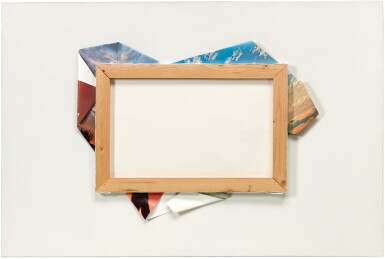Contemporary Art | Milan
Contemporary Art | Milan

Giulio Paolini
ANTOLOGIA (23/4/1974)
Lot Closed
November 27, 03:21 PM GMT
Estimate
120,000 - 180,000 EUR
Lot Details
Description
GIULIO PAOLINI
b.1940
ANTOLOGIA (23/4/1974)
signed, titled and dated 23/4/1974 on the stretcher
reversed canvas and photographic reproduction applied on prepared canvas
This work is registered in the Fondazione Giulio e Anna Paolini, Turin, under the n. GPO-0267 and it is accompanied by a photo-certificate signed by the artist.
(firmato, intitolato e datato 23/4/1974 sul telaio
tela rovesciata e riproduzione fotografica applicata su tela preparata
Opera registrata presso la Fondazione Giulio e Anna Paolini, Torino, con il n. GPO-0267 ed accompagnata da certificato su fotografia firmato dall’artista.)
cm 80x120x4,5; inches 31.5 by 47.2 by 1.7
Framed (con cornice): cm 81,5x121x7,3; inches 32.1 by 47.6 by 2.8
To view Shipping Calculator, please click here
Galleria Notizie, Turin
Private collection, Montecarlo
Sotheby's London, 20th Century Italian Art, 24 October 2005, lot 42
Galleria Tega, Milan
Private collection, Montecarlo
Magazzino, Rome
Cortesi Gallery, Lugano
Acquired from the above by the present owner (Ivi acquistato dall'attuale proprietario)
“To be authentic, a work of art must forget about its author,” asserts the artist, in a statement that recalls Roland Barthes’ influential essay of 1967, ‘The Death of the Author’.
(Giulio Paolini cited in: Tom Jenkins, ‘To Be or Not to Be: Giulio Paolini,’ Port Magazine, July 2014, online).
As a young artist starting out in the 1960s, Paolini was deeply influenced by Piero Manzoni’s inquiries into what constituted art. Taking his cue from the self-assertion of Manzoni’s Achromes and his use of painting as a self-referential discipline, Paolini began to create works that investigated the strange nature of their own being. The materiality of art—literally what pictures are made of—became Paolini’s subject matter, as well as the nature of art as language, and as history. Antologia (23/4/1974) is a perfect example of the artist’s signature style of conceptual art in which the artist’s tools are exposed, exhibited and elevated to intriguing new heights.
The work has a "narrative" structure and presents itself with the formal approach typical of Paolini. The simplicity of the two "reversed" canvases, attached one to the other, so that the canvases look as though they are sealed inside the work. In-between these canvases the artist places a coloured digital print depicting dawns, sunsets and blues skies almost as if wanting to recreate the classical genre of landscape paintings but reinterpreting it in his own provocative and unique style.
“Per essere autentico, un opera d’arte deve scordarsi del suo autore” asserisce l’artista, in una dichiarazione che richiama l’influente saggio ‘La Morte dell’Autore’ di Roland Barthes del 1967.
(Giulio Paolini cited in: Tom Jenkins, ‘To Be or Not to Be: Giulio Paolini,’ Port Magazine, July 2014, online).
Sin dall'inizio della sua carriera artistica negli anni ’60, Paolini fu profondamente influenzato dall’indagine di Piero Manzoni su cosa costituisse l’arte. Prendendo spunto dall'autonomia degli Achrome di Manzoni e dal conseguente utilizzo della pittura come disciplina autoreferenziale, Paolini iniziò a realizzare opere che indagassero la natura stessa del loro essere. La materialità dell’arte diventa soggetto centrale per Paolini, assieme alla natura dell’arte come linguaggio e come storia. Antologia (23/4/1974) è un perfetto esempio dello stile concettuale tipico dell’artista in cui gli attrezzi da artista sono esposti, mostrati ed elevati ad una nuova ed intrigante dimensione.
Il lavoro è sviluppato con una struttura ‘narrativa’ e si presenta con l’approccio formale tipico di Paolini. La semplicità delle due tele preparate ‘invertite’, legate l’una a l’altra, in maniera tale che sembrano quasi sigillate all’interno dell’opera stessa. Tra le due tele, però, l’artista inserisce una fotografia a colori che ritrae albe, tramonti e cieli blu, ricreando il genere classico dei paesaggi, ma reinterpretandolo, con eleganza, nel suo stile unico e provocatorio.
